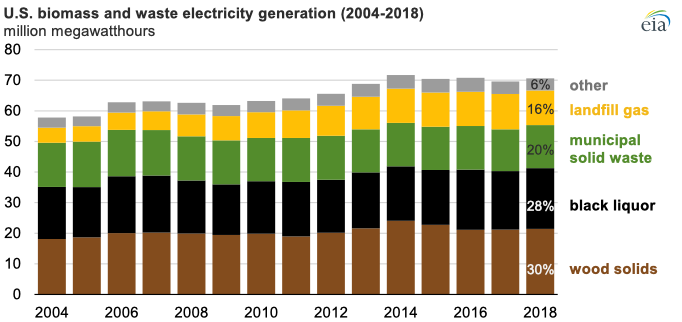Electricity generated from biomass and waste totaled 70.6 million megawatthours (MWh) in 2018, or about 2% of total U.S. electricity generation. Expansion in electricity generation from biomass and waste has ended in recent years, after growing from 2004 through 2014, and in 2018 was 2% below its peak generation of 71.7 million MWh in 2014.
Electricity generation from biomass and waste is a diverse collection of organic feedstocks including wood and wood waste solids, black liquor, municipal solid waste, and landfill gas. These four feedstocks accounted for more than 94% of biomass and waste electricity generation in 2018.

Municipal solid waste (MSW) contains landfill solids of biogenic and non-biogenic origin, which can be used to produce electricity and heat. Generation from MSW has been fairly stable since 2010, as a result of increased recycling activity that has moderated the growth in available MSW feedstock.
In addition to biogenic waste streams, two non-biogenic wastes are often co-processed with biomass wastes to generate electricity: tire-derived fuel (TDF) from used tires and the non-biogenic portion of MSW. TDF fuel is notable because it has the highest heating value of any solid fuel. TDF is also used as a boiler fuel at cement kilns in addition to being co-possessed with MSW to generate electricity. Plastics comprise most of the combustible non-biogenic portion of MSW and account for 16% of the MSW fuel stream.
Landfill gas (LFG) is a methane-rich gas produced by decomposing organic material at landfills. Electricity generation from LFG more than doubled between 2004 and 2014, growing by 6.3 million MWh. LFG generation growth slowed in 2014, as the percentage of U.S. landfill capacity suitable for LFG facilities approached 65% and after 2014 biogas from landfills qualified for cellulosic biofuel credits under the Renewable Fuel Standard.
Principal contributor: Fred Mayes







